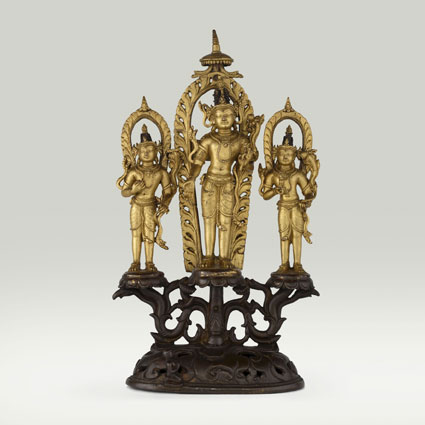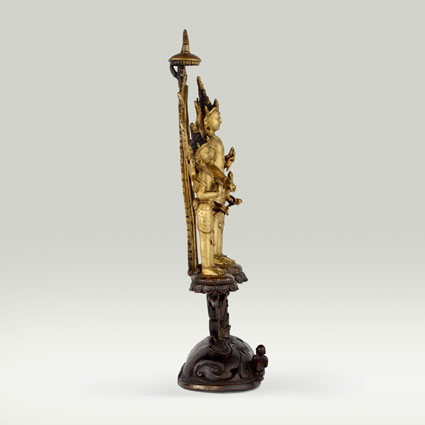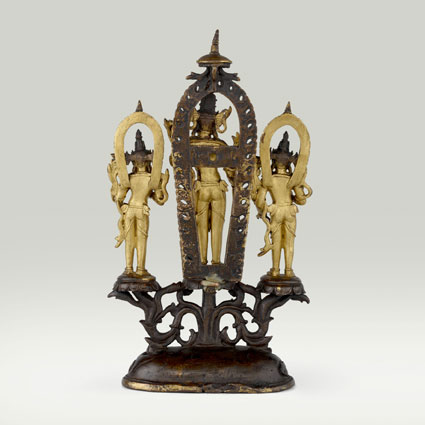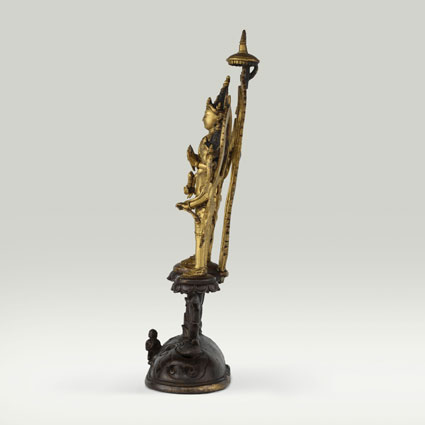Manjushri, Avalokiteshvara and Vajrapani – "Protectors of the Three Spiritual Families"
See it in the Museum

Chapel
Orientation 4
Display 7

ABS 112
Code: ABS 112
Country: China
Style: Qing Dynasty
Date: 1700 - 1800
Dimensions in cm WxHxD: 13.9 x 27.5 x 7
Materials: Brass; images are gilt, pedestal left ungilt
Manjushri, Avalokiteshvara Padmapani and Vajrasattva - “Protectors of the Three Spiritual Families”
This triad of protectors symbolises the three cardinal virtues of wisdom, compassion and action. They are the earliest bodhisattvas of Mahayana Buddhism.
The deities stand in a slightly bent attitude (abhanga) on lotus flowers. Their stems grow out of an oval shaped stand.
Avalokiteshvara Padmapani occupies the center and extends his right hand in the gesture of charity (varada mudra), while his left holds the stem of a lotus flower (padma) blossoming above his left shoulder. On his head rests a small effigy of Amitabha. Manjushri to his proper right turns his right hand inwards toward his chest, while with his left hand he holds the stalk of a blue lily (nilotpala) on which a manuscript (pustaka) of the Astasahasrika Prajnaparamita Sutra rests. Vajrasattva to the proper left side of Avalokiteshvara Padmapani holds a diamond scepter (vajra) in his right hand and with his left the stalk of a lily (utpala) on which a prayer-bell (ghanta) rests. Avalokiteshvara Padmapani is encircled by an aureole surmounted by a stupa. The heads of the two side figures are set off against pointed nimbuses.
During the Qing dynasty, the imperial workshops produced many copies of Tibetan, Nepalese, and Indian statues such as this Chinese Pala replica. In the collections of the Forbidden City (Zijin Cheng) in Beijing are a number of replicas of which the Tibetan, Nepalese, and Indian originals have survived.
This triad of protectors symbolises the three cardinal virtues of wisdom, compassion and action. They are the earliest bodhisattvas of Mahayana Buddhism.
The deities stand in a slightly bent attitude (abhanga) on lotus flowers. Their stems grow out of an oval shaped stand.
Avalokiteshvara Padmapani occupies the center and extends his right hand in the gesture of charity (varada mudra), while his left holds the stem of a lotus flower (padma) blossoming above his left shoulder. On his head rests a small effigy of Amitabha. Manjushri to his proper right turns his right hand inwards toward his chest, while with his left hand he holds the stalk of a blue lily (nilotpala) on which a manuscript (pustaka) of the Astasahasrika Prajnaparamita Sutra rests. Vajrasattva to the proper left side of Avalokiteshvara Padmapani holds a diamond scepter (vajra) in his right hand and with his left the stalk of a lily (utpala) on which a prayer-bell (ghanta) rests. Avalokiteshvara Padmapani is encircled by an aureole surmounted by a stupa. The heads of the two side figures are set off against pointed nimbuses.
During the Qing dynasty, the imperial workshops produced many copies of Tibetan, Nepalese, and Indian statues such as this Chinese Pala replica. In the collections of the Forbidden City (Zijin Cheng) in Beijing are a number of replicas of which the Tibetan, Nepalese, and Indian originals have survived.





